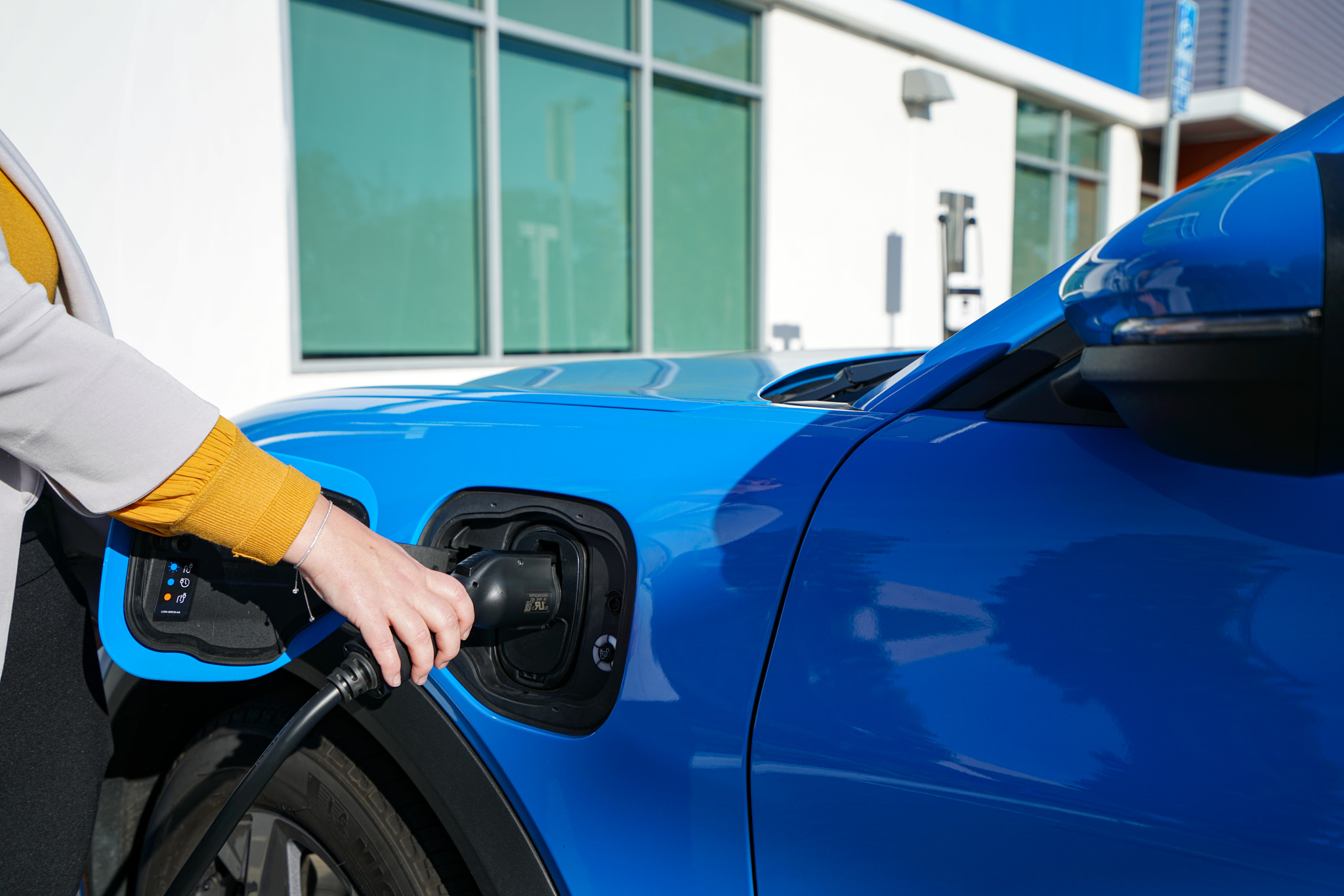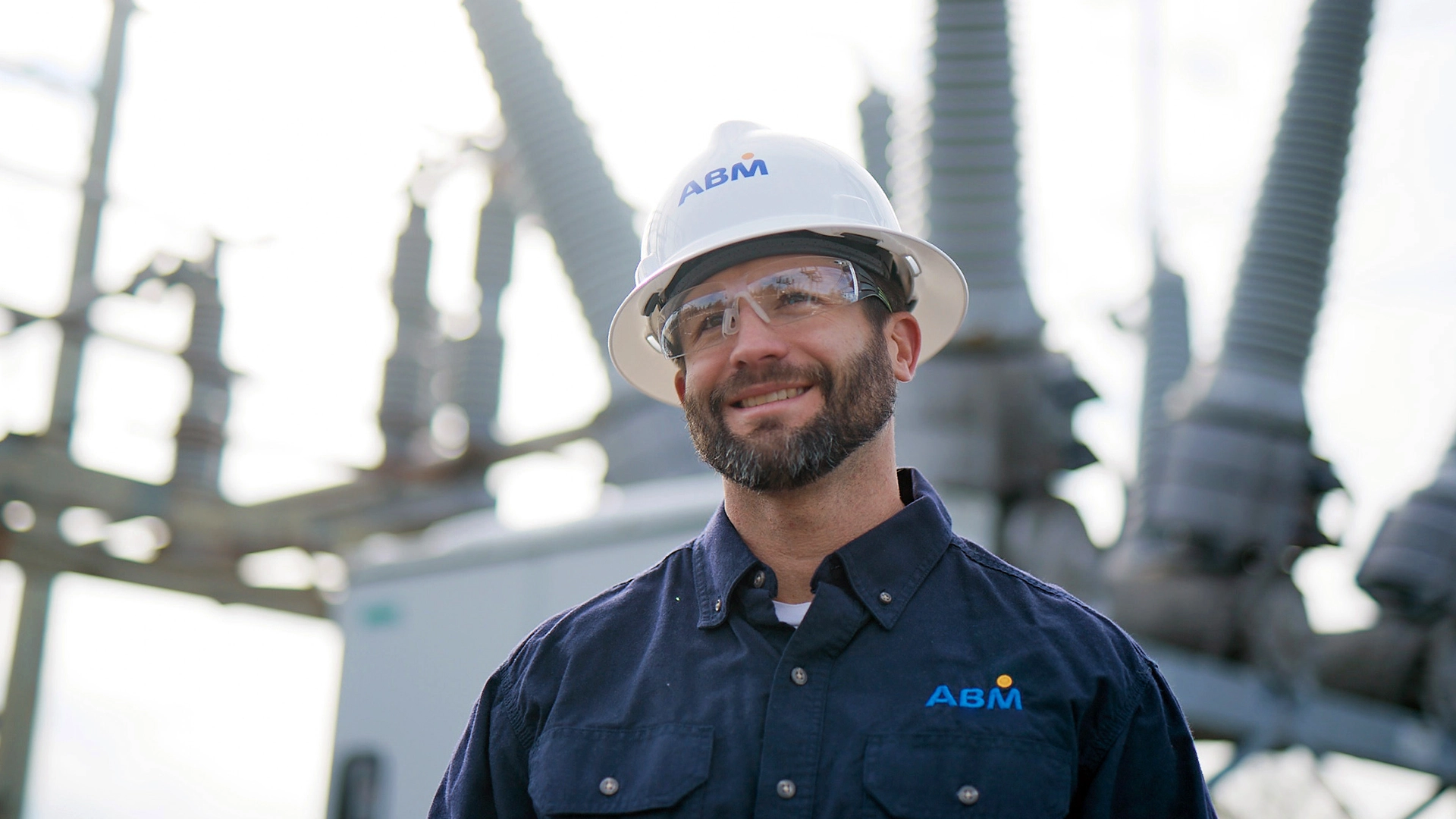Expert answers to every EV question
What’s the easiest road to EV success for my facility?
Answer: ABM solutions make EV charging infrastructure a key feature of your facility. And you get all of the power—with none of the hassle.
The journey to broad EV adoption in the U.S.
The number of electric vehicles on American roads is increasing daily—and it’s elevating the nationwide demand for more public and private EV charging stations.
Expert forecasts¹ estimate that by 2030, 28 million EVs will enter the American auto market. Meanwhile, the EPA has announced expected new emissions rules that will result in EVs attaining a roughly 60% market share of all vehicles by the same year.² To power those, the U.S. will need 700,000 Level-2 chargers and 70,000 Level-3 chargers. That’s an 8-fold increase in the country’s EV charging infrastructure in just 7 years.
To help make this possible, the federal government has allocated $5 billion over the next half-decade to increase EV charging infrastructure, promising to fund half a million chargers.
In short, the nation’s headed straight into an era of hyperspeed growth in the EV market, and your facility needs to be ready to support it.
Your on-ramp to easy EV implementation: ABM
Are you reading these figures and feeling overwhelmed, lost, confused or unsure of how or where to start? Like it’ll be impossible for you to meet the demand? Let ABM draw you a map for how to best get EV infrastructure at your facility.
As daunting as the prospect of charger proliferation sounds, our EV experts have enabled thousands of physical locations spanning over 15 different industries to meet the current and forthcoming demands of EV charging.
As the nation’s largest commercial installer of EV charging solutions, we are perfectly positioned to upgrade your systems and infrastructure to meet demand. We have the hardware, software, expertise, and financing structures to support you every step of the way. Plus, we’ve got more than a decade of experience—and over 28,000 installed EV charging ports—to prove it.
In short, if you’ve got EV questions, we’ve got EV answers.
Read this guide to get many of them right now. In it, we address the four primary barriers to success head-on:
Barrier 1 - Where to begin and how to scale
Barrier 2 - The costs, financing options, and financial structures
Barrier 3 - Finding the right solution for your specific facilities
Barrier 4 - Implementing in an uncertain economy
Once you know what you’re up against, we can start solving for it together, in a way that best benefits your facility and the people in it.
What questions should I be asking about EV charging infrastructure?
Answer: If you’re not sure where to start, don’t worry —we’ve already asked and answered all the questions.
EV charging technology is just now becoming widely demanded, mandated, and adopted. As a result, many facility owners and managers aren’t completely familiar with the details, specs, and requirements of implementing EV at their facilities. At the same time, they have reasonable concerns surrounding making a significant investment in EV charging infrastructure.
They worry that the EV installation market is:
- Not yet mature
- Fragmented
- Full of jargon
- A sea of sameness
- Highly focused on software-enabled charging ports
Furthermore, EV marketing often loses track of the primary beneficiaries of the technology: EV drivers, the environment and the client’s business. Thus, facility owners and managers are uncertain on the best path forward, what sort of investment to expect and the ongoing costs and management requirements for maintaining the charging systems
Steering the EV rollout in the right direction
In December 2021, the Biden-Harris Administration unveiled its “EV Charging Action Plan”³ to outline steps federal agencies are taking to standardize, streamline and support the efforts to develop and deploy EV chargers in American communities across the country. As part of that plan, the Bipartisan Infrastructure Law includes $5 billion in funding for building a national EV charging network.
Consulting firm McKinsey & Company⁴ emphasizes not only the pressing need for increased EV charging infrastructure, but also consideration around the distribution and placement of such infrastructure:
“An important principle to consider is placing public chargers where EV owners will charge their vehicles. This point may seem obvious, but it can be challenging to accomplish in practice. By distributing public chargers in the right numbers and places, states and companies can analyze the driving and parking behavior of motorists in detail at the local level.”
The President is laying the foundation for a nationwide network of EV charging infrastructure to provide a reliable, affordable, convenient, seamless user experience that is equitable and accessible for all Americans. As a result, EV charging stations are now being required across a variety of facilities and industries:
Parking Structures
Commercial complexes, airports, shopping centers, hospitals, schools and campuses
Governments & Municipalities
City, county, state, federal; public access to charging at downtown parking and shopping, and as an employer, for EV fleets
Commercial & Industrial Buildings
Employer workplace locations and EV fleets
Large Entertainment Venues
Stadiums, theme parks and concert venues
Mixed-Use Facilities
Multi-tenant/multi-family building owners will need to accommodate EV drivers
Public & Private Fleets
Electric buses and shuttles need access to efficient charging
Beyond convenience, the EV chargers are also helping these facilities meet their green building initiatives and sustainability goals⁵, including improving air quality and reducing emissions. They’re also supporting our nation’s larger goals of creating a path to lower emissions by 2050 and positioning U.S. industries to lead these global efforts. In summary, the best time to start investing in EV charging infrastructure was yesterday. The next best time is right now.
How do I prepare my facility for the EV revolution?
Answer: Here’s your EV roadmap. We drew it just for you.
The right EV solution takes everything into account from the beginning. Financing and procuring for charging stations. Dynamic pricing models based on demand. Ongoing service and maintenance. All with an eye on long-term sustainability.
Here’s how ABM builds your custom, scalable EV roadmap for implementing charging technology and capabilities at your facility:
1. SITE CONSULTATION & ANALYSIS
ABM will help identify the optimal configuration to incorporate EV charging infrastructure while minimizing disruptions to your existing operation.
2. EQUIPMENT & NETWORK SYSTEM SELECTION
ABM provides the EV chargers and operating software that ensure a smooth equipment installation or upgrade.
3. FINANCING STRUCTURE & INCENTIVES
ABM helps you identify and secure local, state and federal funding, and provides financing for multi-year projects. Whether through a service-based structure, private or public funding, ABM works with you to uncover new financing options.
4. DESIGN, INSTALLATION & ELECTRICAL TESTING
ABM experts design the EV charger installation—ensuring your facility has the right power distribution assets and capacity—whether you install Level-2, Level-3 or a combination of charging ports. Then, our accredited electrical testers perform compliance and safety assessments on all of it, ensuring dependability, reducing liability and protecting the people using your charging equipment per NFPA 70E standards.
5. ONGOING SERVICE & MAINTENANCE
After installation, your dedicated ABM team remains an active partner. This includes regular maintenance and any needed lifecycle service and futureproofing upgrades to keep pace with evolving technology and regulations.
6. CONTINUOUS MONITORING, ANALYTICS & REPORTING
ABM provides dashboards with savings, sustainability and performance metrics all in one place. This empowers you with usage rates, monetization, power management and the additional data you need to report to your stakeholders and community. All to help you minimize costs, maximize revenue and make informed decisions about your pricing and programs.
Throughout it all, ABM is your single point of contact operating right by your side, answering every question and ensuring that you make the best choices today—while remaining flexible and ready for the future of EV.
Why trust ABM as an authority on EV infrastructure?
Answer: We’ve got more than a decade of experience—and over 28,000 installed EV charging ports to prove it.
During our more than 110 years as a facility services provider and innovator, we’ve helped facilities evolve to meet tech demands—thousands of times. EV is the latest tech to be woven into the fabric of facilities, and our experts can answer any question about it.
With our extensive experience in parking management and energy-saving solutions, ABM helps your facility navigate the intersection of evolving technology, power requirements and operations that impact successful EV charging infrastructure. And our proven experience in eMobility means that we know how to expedite the implementation process and help you plan for your facility’s future.
Facilities of all sizes partner with ABM. Our scale and breadth of expertise enable us to offer custom, cost-effective solutions that serve your drivers, your objectives and your bottom line. ABM is uniquely positioned to help you design and implement custom, innovative EV charging projects. Our teams self-perform installation, power distribution upgrades and cost-effective preventive maintenance, bundling the services you need to create a customized EV solution for your facility.
- #1 commercial installer of EV chargers in the U.S
- 28,000+EV charging ports installed
- $1.5 Billionin parking revenue collected for ABM clients
- 400,000+maintained parking lots (and equipment)
- 230+major cities served
- 10+years of EV charging experience
- 93% customer retention rate
Answer: An entire training centerand program dedicated just to EV
ABM is investing in the buildout of a more than 114,000+ sq ft. facility that will soon become the home for all of its EV innovation. The electrification center will house our eMobility and power grid headquarters and state-of-the-art EV training and commissioning facilities.
Specifically designed for technical trades, and with space dedicated to hands-on training, the center features the following:
- Warehouse for ABM EV chargers, EV OEM spare parts and pre–commissioning
- Advanced repair support services facility
- Indoor EV charging development and testing lab to support vehicle interoperability testing with our clients
- Exterior EV charging hub for DC Level-3 and AC Level-2 charger
Alongside the development of its electrification center, ABM has also launched its new ABM Certified EV Charger Technician program, which will be the first-of-its-kind OEM-agnostic training program. Consisting of three tiers of certification and bringing together ABM’s world-class service and maintenance, our deep understanding of EV charging will fully develop the next generation of EV service technicians.
Answer: The added value of unmatched expertise6
A successful EV installation requires more than a trained technician. It takes experience working alongside cities and utilities, engineering excellence and the exceptional customer service skills of a qualified EV charging partner. Here’s everything else ABM offers.
- Single source provider for consultation, selection, configuration and pricing, installation, permitting, testing and maintenance
- Lower electricity rates through our supply-side power offerings
- Building and facility services to improve energy efficiency through HVAC, mechanical, electrical and LED lighting and intelligent lighting controls
As the largest commercial installer of EV charging stations in the U.S., ABM is perfectly positioned to upgrade your EV systems and infrastructure. We have the hardware, software, expertise and financing structures to support you every step of the way. With us, you’ll be ready to meet the impending, growing demand for EV.
How many EV charging stations, and which types, do I need?
Answer: It all depends on your goals, footprint and the investment you want to make in your facility’s EV infrastructure. But, no matter which way you choose to go, ABM can get you there.
As electric vehicles continue to evolve, ABM can help you lead the charge by right-sizing your EV assets and maximizing their useful service life.
Here’s a quick overview of the three main types of EV charging technology
Level-1 Charging – Uses a standard 110/120-volt receptacle
- A simple cord with an adapter uses a standard AC wall plug on one end and the EV’s standard charging port on the other. This offers a slow “trickle” charge that is best suited for emergency charging, as it only provides a limited extension of the vehicle’s range over a long-duration charge.
Level-2 Charging – Uses the 208/240-volt SAE J1772 port for faster charging
- It can be anywhere from 3.5 to 10 times the speed of a Level-1 charger (4-6 hours to fully charge a small EV).
- With their relatively low cost and moderate electrical infrastructure demands, Level-2 stations have become both the global industry standard and the practical standard for the majority of sites.
- Keen eyes will notice a growing number of charging stations popping up in key metro areas at retailers, public parking sites, office buildings, parking structures and residences.
Level-3 Charging (DC Fast Charging) – 480 volt, very fast charging for automobiles equipped with the Fast Charging option
- DC Fast Charging can charge a small EV to 80% of its capacity in less than 30 minutes.
- Unlike Level-2, where there is one global standard, Level-3 chargers have at least three “competing standards.” These standards have regional roots, yet both are battling for global dominance. It will take some time to see if the industry moves to a single option or if we live with two for the foreseeable future8.
No matter which type you need, ABM teams know how to design efficient, safe and dependable EV installations
Meeting high-voltage requirements
These days, it’s become common to see chargers with more residential specifications, such as 240V, 20A. Now, 40A circuits are needed for AC charging.
For DC Fast Charging, 50kW and 400V have been the norm. And that’s poised to increase to 800V at 350kW of charging. Meanwhile, the market is already looking ahead to 1,000kW (1MW) and 1,200V.
Many commercial electricians are not required to work with voltages higher than 480V phase-to-phase, and many work mostly with AC power. DC Fast Charging means more technicians will need to be trained to work on DC at the 1,000V (soon to be 1,200V) level. This means a change in the insulation rating of the wiring needed, a change to the personal protective equipment (PPE) requirements for the job and a big change to your training plans.
To operate in this increasingly charged environment, ABM has fully trained its personnel across the board—not just techs. Our field electricians all possess the appropriate skills and PPE for handling higher voltage equipment. In addition, our estimators, designers and project managers are well-versed in the increased power requirements and working practices required.
What are the right EV chargers to meet my needs and demand?
Answer: ABM provides and installs world-class charging technology. We’ll work with you, your facility and your goals to implement the best possible EV charging hardware
From entry-level charging solutions to the latest smart EV Level-2 charging stations and Level-3 heavy duty fleet chargers, our options are perfect for any location, including hotels, offices, entertainment venues, residential parking lots and more.
- Fast time-to-market
- Low development costs
- Best-in-class reliability
- Comprehensive product support
How do I monitor and optimize the usage of my EV charging stations?
Answer: Our intelligent, proprietary EV OS software enables you to balance comprehensive reporting, energy management and automatic peak-hour pricing in a few clicks.
ABM doesn’t just specialize in charging hardware. Our EV OS software suite is a versatile, cloud-based operating platform that can run a single charging station or a network of charging stations across multiple locations.⁹
Utilizing smart algorithms and intelligent monitoring, the software balances electrical usage, optimizes available power usage and protects local electrical systems from overloading.
ABM EV OS also offers flexible implementation options to suit your ideal number of chargers. It’s part of the complete charging package that ABM offers industries and facilities.
Core Services
- Remote operation management that is scalable and brings a single charging site or entire charging network into focus on a single platform
- Easy access information management includes the location and photos of each charging site
- Comprehensive reporting with automatic peak-hour pricing and cost optimization
- Automatic infrastructure diagnostics that reduce downtime and enhance visibility to ABM service and maintenance teams
Microservice Library
- An ever-expanding library of microservices and timely custom implementation that can fit any business needs
- Energy management, enablement and promotion features to optimize operation
Advanced Services
- Customizable solutions for business and charging network operators of any size
- Build your own charging ecosystem through API integrations including rewards programs, building entry badges and parking systems
What EV financing, tax incentives, grants and rebates can I get for my facility?
Answer: Our experts help you identify governmental funding and financing options for your facility to help you pay—and pay less—for your EV charging infrastructure.
The installation of EV charging infrastructure is supported by subsidies and rebates at the federal, state and local levels.¹⁰ Local governments as well as utilities providers offer an array of tax credits, rebates and grants to help offset the installation and operating costs of an EV charging network.
While most people are familiar with the federal tax credits available for installing EV chargers, many are unaware of additional programs that may be available. Right now, 63% of the country is covered by a rebate or incentive for installing an EV charger.Representative programs include:¹²
The National Electric Vehicle Infrastructure (NEVI) Formula Program¹³
- Allocates $5 billion in funding for EV charging infrastructure along 75,000 miles of highway across the country.
- Your facility must be within one mile of an established alternative fuel corridor to qualify and may need to meet other requirements as well.
The 30C Alternative Fuel Infrastructure Tax Credit¹⁴
- Commonly referred to as the “federal tax credit,” gives qualifying businesses a 30% tax credit, up to $100,000, for the purchase and installation of EV charging infrastructure.
- Businesses must have installed the stations between Jan. 1, 2023, and Dec. 31, 2032, and must claim the credit on their federal tax return.
Numerous State & Local Incentives & Laws¹⁵
- There is a wide number of state and local laws and incentives that encourage or require the use of alternative fuels, electric vehicles, EV charging station design guidance, EV ready building requirements or strategies to decrease fuel use or increase fuel economy.
Having done this for over a decade with a dedicated Rebate & Incentive team, ABM constantly tracks available EV programs by state. All to help you get as many tax credits, rebates, grants and incentives as possible— and to minimize the cost of your EV implementation.
What environmental and sustainability benefits can EV deliver for my facility?
Answer: From reduced carbon emissions to reducing our reliance on fossil fuels to eliminating greenhouse gases, EV chargers are as good for the environment as they are for your operation
The environmental impacts of EV charging solutions
ABM is the largest installer of electric vehicle charging stations in theU.S. To date, we have installed more than 28,000 EV charging stations.
This means we’ve helped our EV clients and their customers to avoid:
- 3,849,000pounds of greenhouse gases and other emissions
- 1,746tons of CO²e/kWh—and a fuel cost of over $658,000
- 196,000gallons of gasoline and diesel fossil fuel use
We also helped increase our clients’ waste-diversion rates, reduce their operating costs and achieve LEED and True Zero Waste certification credit points with our waste management services.
Our broader sustainability efforts
Beyond our EV solutions, ABM has also helped our customers and their facilities achieve their sustainability goals. In total, we’ve helped them to save, reduce or avoid:
- $275,000from utilizing electricity to displace fossil fuels
- 5,800tons of greenhouse gases (GHG)
- 3,500pounds of nitric oxides(NoX)
- 5,600pounds of volatile organic compounds (VOCs)
- 300pounds of particulate matter
We also helped increase our clients’ waste-diversion rates, reduce theiroperating costs and achieve LEED and True Zero Waste certification credit points with our waste management services.
- 361 million square feet of our clients’ facilities implemented our Green Cleaning and GreenCare® programs
- 450USGBC LEED-certified and LEED-registered sites serviced
In 2022, ABM earned a SEAL Award, recognizing it as one of the “50 Most Sustainable Companies in the World” for its impactful and innovative environmental initiatives.¹⁶
Need more than just EV solutions for your parking facility?
Answer: Introducing ABM Vantage™. An integrated mobility solution that unifies your data and maximizes your revenue so your operation can do more. It’s Parking Unparalled.
ABM Vantage makes parking simple by unifying diverse component systems to seamlessly manage, maintain and modernize parking.
Unconstrained Data Insights
- ABM Vantage centralizes all your data from existing subsystems into a single source of truth—giving you new insights to better forecast and anticipate demand.
Unrivaled Revenue Optimization
- Through capacity planning and dynamic pricing, ABM Vantage accelerates your ability to maximize value through new products and revenue streams.
Uncompromising Operational Efficiency
- ABM Vantage streamlines how people move through your facility—reducing bottlenecks and operational costs while bringing greater efficiency to your operation.
Unprecedented Driver Experience
- Whether your drivers are fans, employees, students, tenants or visitors, exceed their evolving expectations with touchless payment and online booking—including VIP, Valet and EV-charging capabilities.
So, what’s the ROI on EV?
Answer: Happier tenants and visitors. Fewer carbon emissions. Cleaner air. Less energy waste. Lower energy bills. Greater revenue for your facility.
Preparing your facility for the forthcoming EV revolution is smart for everyone.
EV charging stations provide a new revenue stream for your facility, improve your sustainability metrics and support the evolving lifestyles and preferences of tenants and customers.
Sources:
1. Electrek.co – 2022 S&P Global Mobility forecast – “Here’s how many EV chargers the US has – and how many it needs”
2.Electrek.co – “EPA releases new emissions rules: 60% EV by 2030, saves US trillions”
3. The White House – “Fact Sheet: The Biden-Harris Electric Vehicle Charging Action Plan”
4. McKinsey & Company – “Building the electric-vehicle charging infrastructure America needs”
5. ABM – “EV Infrastrucutre 101: An Early Market EV Whitepaper from ABM for Facility Managers”
6. ABM – “Simplifying the path to EV”
7. ABM–“EVInfrastrucutre101:AnEarlyMarketEVWhitepaperfromABMforFacilityManagers”
8. ABM – “EV Infrastrucutre 101: An Early Market EV Whitepaper from ABM for Facility Managers”
9.ABM–“EVOSPlatformFeatures&Benefits”
10. U.S. Department of Energy – Energy Efficiency and Renewable Energy – “Electricity Laws and Incentives”
11. BriteSwitch – “Rebates for EV Chargers. Do you qualify?”
12. U.S. Department of Energy - Alternative Fuels Data Center - “Electricity Laws and Incentives in Federal”
13. Federal Highway Administration - Bipartisan Infrastructure Bill - “The National Electric Vehicle Infrastructure(NEVI) Formula Program Guidance”
14. U.S. Department of Energy – Energy Efficiency and Renewable Energy – “Alternative Fuel Infrastructure Tax Credit”
15. U.S. Department of Energy – Energy Efficiency and Renewable Energy – “State Laws and Incentives”
16. ABM – “ABM’s eMobility Solutions Recognized with Prestigious SEAL Business Sustainability Award”





